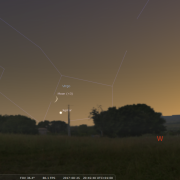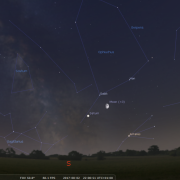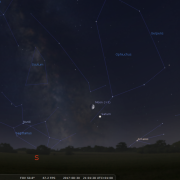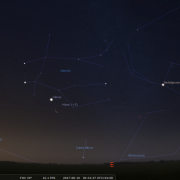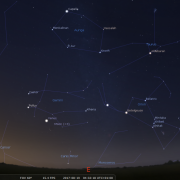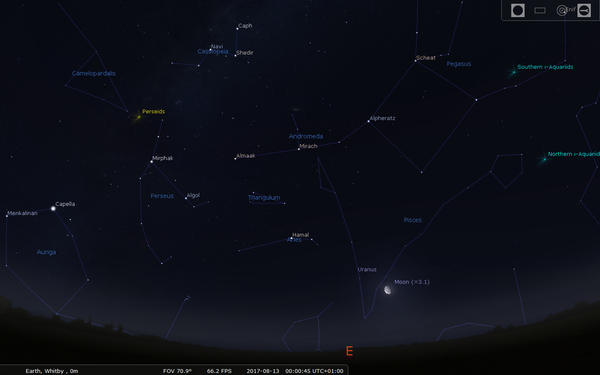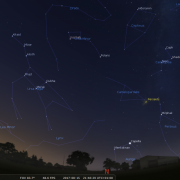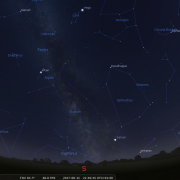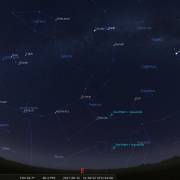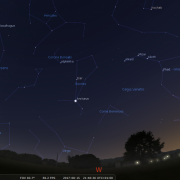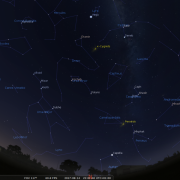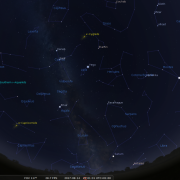Welcome to the WDAS monthly newsletter for August 2017: a digest of the month's latest contributions to our website. Below you'll find Society News, Sky Notes and In-Focus articles printed in full. There's also future events, and trailers for other articles which appear in full on the website - just a click away!
Society News

A case of déjà vue here as both events scheduled for early July, just like June, went ahead allowing observations of the Sun, moon Jupiter and Saturn, pretty much the only celestial objects on show. The event on the 9th was particularly interesting as we were able to view the setting Sun, complete with a sunspot grouping and a thin strata layer of cloud seemingly cutting its disk in two. A running theme as it turned out, the rising full moon also subject to a similar effect, visually pleasing through the eyepiece.
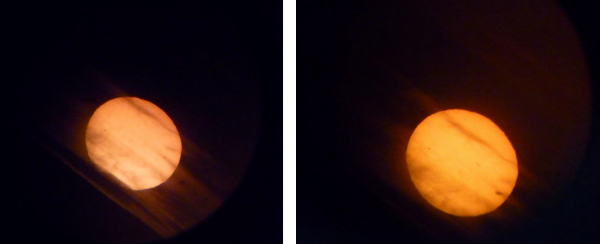
Although Jupiter remained stubbornly obscured by a cloud bank, Saturn was on show between clear slots in the cloud to the south. Of course Saturn has the rings cutting through its disk (seemingly) so i guess the theme continued. The gathered crowd more than satisfied with observations of these objects, indeed it was quite a late night with people eager to view right up to packing up time – 23:15h.
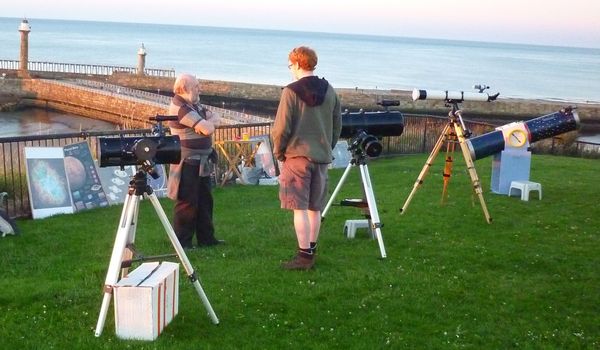
Our luck ran out for the two events at the end of July on the 28th and 29th. The Friday evening party was rained off, and as I write this the Saturday event will fall victim to cloud cover, with the likely hood of rain later. It’s good to tell August is almost upon us and the schools are off!
Mark will be away for the weekend of the 5th/6th/7th, and we would normally have had a star party, so unless anyone wants to step up the next one will not until the 11th/12th of Aug – whichever is the better night.
We have finally arranged a date for the postponed star party event at the holiday site. The event will take place on August 26th from 20:30h. Society members intending to come along, and can also bring a scope please be there for 20:15h.
Details of the site are included in the Events Calendar. It should be good evening (weather permitting) with little light, great views and hopefully a healthy turnout from site occupants.
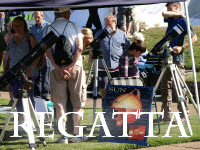 Not long before we hit the peak season (we hope) as regards star parties.
Not long before we hit the peak season (we hope) as regards star parties.
The Regatta events follow the usual route – afternoon solar viewing, on the Saturday (19th) and Sunday (20th), with evening star parties on both dates. The location of the solar viewing i assume will be as last year ie – the grassy area adjacent to the small Go carts and Royal Crescent on the West Cliff. Time wise 2 – 16:30pm. The Star parties will be held on the pitch and put area, above the archery green – as per last year. Parking is adjacent to this area - down the side of pitch and put, accessed over the parking area behind the bowling green. It is actually quite convenient. We shall be setting up by 20:30h. If the weather is good and you can make it, assistance would be most welcome.
As for the rest of August – we have Folk week and the bank holiday events to look forward to. August dates seem to be very susceptible to the weather, so i have put quite a few dates down. Expect half to be called off. Again if it is a fine night on a scheduled date and you can make it please do come along.
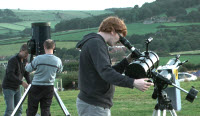 With a waxing moon lighting up the sky throughout our normal date frame period, our visit to Hook’s House is a little tricky this year. The full moon occurs on the 6th, so our options are a bit limited. After consideration we have decided to go ahead for the 1st Sept (Friday) this at least is 5 days before full moon and the campsite should be still busy. We will be looking at setting up equipment for around 20:00h – the moon will be a across in the south and Saturn will still be visible. If the weather is fine it should be a cracking evening.
With a waxing moon lighting up the sky throughout our normal date frame period, our visit to Hook’s House is a little tricky this year. The full moon occurs on the 6th, so our options are a bit limited. After consideration we have decided to go ahead for the 1st Sept (Friday) this at least is 5 days before full moon and the campsite should be still busy. We will be looking at setting up equipment for around 20:00h – the moon will be a across in the south and Saturn will still be visible. If the weather is fine it should be a cracking evening.
We will be visiting Westerdale in September, although i am awaiting contact, the most likely dates being the 15th or 16th. Again this will be firmed up in the September notes.
Sky Notes
In this month's Sky Notes:
Planetary Skylights

 Jupiter is starting to slide down into the brighter evening twilight low in the WSW, but remains on view throughout August, setting by 21:00h at the end of the month. Look for a bright object as dusk falls. Although Jupiter will be lower, it is nevertheless well worth observing, especially at the start of August. Look in particular for the dark banding across the disk and the Galilean moons; the configuration of which alters each night. The Moon lies nearby Jupiter on the 25th.
Jupiter is starting to slide down into the brighter evening twilight low in the WSW, but remains on view throughout August, setting by 21:00h at the end of the month. Look for a bright object as dusk falls. Although Jupiter will be lower, it is nevertheless well worth observing, especially at the start of August. Look in particular for the dark banding across the disk and the Galilean moons; the configuration of which alters each night. The Moon lies nearby Jupiter on the 25th.
 As twilight falls Saturn is located quite low in the SWS in the constellation of Ophiuchus – the Serpent Bearer. Look for a conspicuous pearly white ‘star’ in that direction. A modest telescope will reveal the ring system, which is orientated favourably at present; but due to low altitude patience is required at the eyepiece, waiting for those tantalising steady seeing moments. Look for the major gap in the rings, the Cassini division) and Saturn’s largest moon, Titan, visible as a speck of light close by. Our moon lies nearby on the 2nd and 3rd of Aug and again on the 30th.
As twilight falls Saturn is located quite low in the SWS in the constellation of Ophiuchus – the Serpent Bearer. Look for a conspicuous pearly white ‘star’ in that direction. A modest telescope will reveal the ring system, which is orientated favourably at present; but due to low altitude patience is required at the eyepiece, waiting for those tantalising steady seeing moments. Look for the major gap in the rings, the Cassini division) and Saturn’s largest moon, Titan, visible as a speck of light close by. Our moon lies nearby on the 2nd and 3rd of Aug and again on the 30th.
 Venus is visible in the pre-dawn sky located low in the ENE from around 03:00h. The brilliant ‘morning star’ should be unmistakeable, especially as we head deeper into August as nights (and early mornings) grow darker. The moon lies nearby on the 19th.
Venus is visible in the pre-dawn sky located low in the ENE from around 03:00h. The brilliant ‘morning star’ should be unmistakeable, especially as we head deeper into August as nights (and early mornings) grow darker. The moon lies nearby on the 19th.
Meteors & Comets
One of the highlights on the astro-calendar, the Perseid meteor shower, peak on August 12th this year, the problem being this coincides with a waning gibbous moon, rendering many of the fainter meteors invisible, particularly post midnight.
Perseids are so called because their radiant; the location in the sky from which they appear to emanate, lies within the constellation of Perseus. In some regions of the world the Perseids are also known as "The Tears of St. Lawrence", or the ‘Fiery Tears’ because the feast day of that saint falls on Aug 10th, just two days before the meteor peak.
Perseids are associated with debris left by the periodic comet Swift Tuttle, deposited over many thousands of years. Each August Earth ploughs through strands of this debris, giving rise to the Perseid shooting stars. This 'debris' is typically the size of instant coffee granules, with the occasional pea or marble sized fragment which ‘burn up' (ionize) at altitudes of around 60 miles reaching speeds of 39 - 45 miles per second.
As for observing, all is not quite lost, as Perseids will be visible in the pre-midnight sky on the 12th, (when most casual observers go out to watch anyway) As we draw closer to midnight and into the early morning hours of the 13th, (usually the optimum time for Perseids) only the brighter shooting stars will be visible, light from the moon drowning out the remainder. Expect actual observed numbers of 15- 25 from 22:00h -midinght, and less than 8 per hour post midnight. The most rewarding regions of the sky for spotting Perseids lie within the 'Summer Triangle' - visible high to the south, the 'Plough' – high to the NW and the Square of Pegasus – midway up in the east.
August 2017 Sky Charts
|
Looking North
Mid-August - 21:45h |
Looking South |
|
Looking East
Mid-August - 21:45h |
Looking West
Mid-August - 21:45h |
| Northern Aspect Mid-August - 22:00h |
Southern Aspect Mid-August - 22:00h |
Additional Image Credits:
- Planets and Comets where not otherwise mentioned: NASA
- Sky Charts: Stellarium Software

